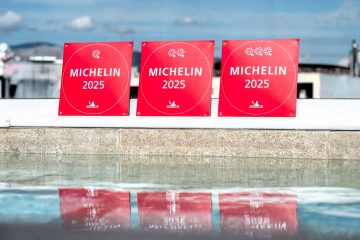Imagine a landscape sculpted by giants, where jagged limestone karsts pierce the clouds, emerald rice terraces cascade down impossibly steep slopes, and ancient traditions whisper from every hillside village. Welcome to Ha Giang, Vietnam’s northernmost province, a realm of unparalleled beauty and raw adventure. This isn’t just a destination; it’s a pilgrimage for the soul, a journey into the heart of a culture as vibrant and resilient as the mountains themselves.
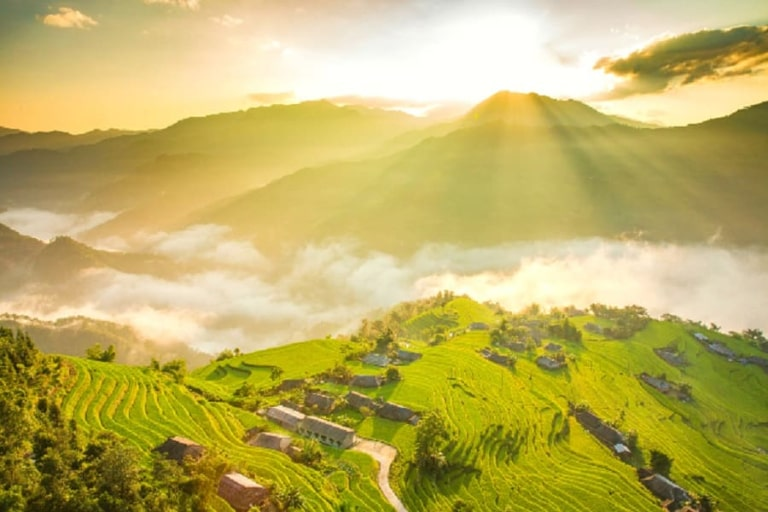
Ha Giang is a siren call for intrepid travelers, drawing them into its embrace with promises of breathtaking vistas, authentic encounters, and the thrill of the open road. While the legendary “Ha Giang Loop” is often the star, the province offers so much more – from cascading waterfalls to vibrant ethnic markets and serene homestays that offer a genuine glimpse into local life. If you’re yearning for an escape from the ordinary, for an adventure that will awaken your senses and redefine your understanding of beauty, then Ha Giang is waiting.
This comprehensive guide will equip you with everything you need to plan your epic Ha Giang journey in 2025 and beyond. We’ll cover the best times to visit, essential packing tips, the iconic Ha Giang Loop, cultural insights, tantalizing local cuisine, and crucially, how to ensure seamless and comfortable transportation throughout your exploration.
Maybe you are interested: 10 Unforgettable Tourist Destinations in Sapa – Halong Transportation
Table of Contents
Why Ha Giang? A Tapestry of Grandeur and Authenticity
Ha Giang is often lauded as the most spectacular region in Vietnam, and for good reason. It’s a place where nature’s artistry is on full display, woven together with the rich cultural fabric of its diverse ethnic minority communities.
Here’s what sets Ha Giang apart:
The Dong Van Karst Plateau Geopark: A UNESCO Global Geopark, this geological marvel is the backbone of Ha Giang’s stunning landscapes. Millions of years of tectonic activity have created a labyrinth of towering limestone peaks, deep canyons, and unique rock formations that will leave you awestruck.
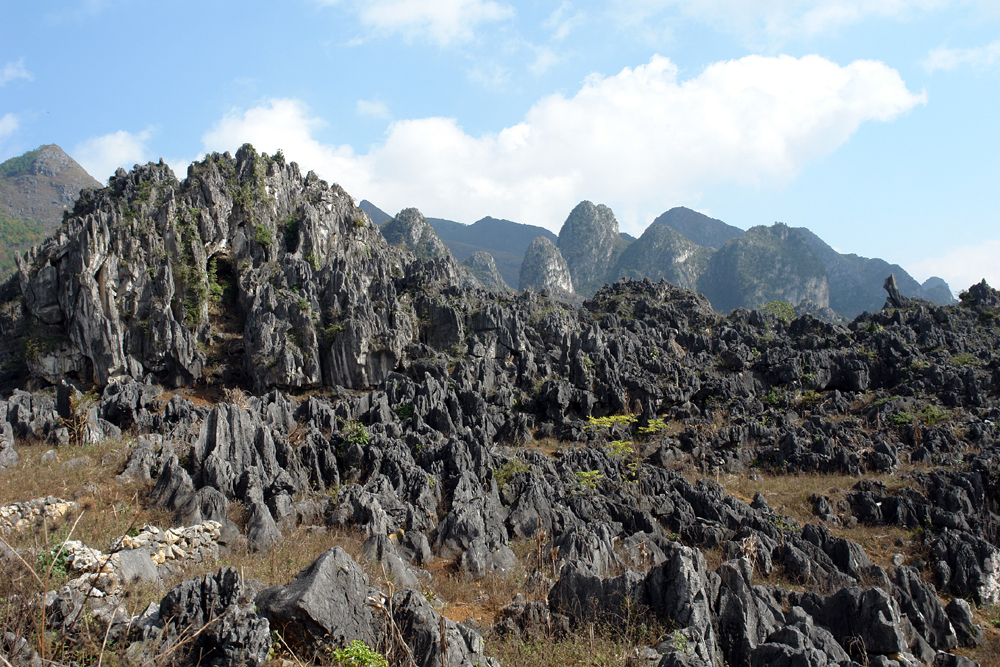
The Ma Pi Leng Pass: Often dubbed the “King of Passes” in Vietnam, this winding mountain road offers panoramic views of the Nho Que River snaking through a dramatic gorge below. It’s a sight that will etch itself into your memory forever.
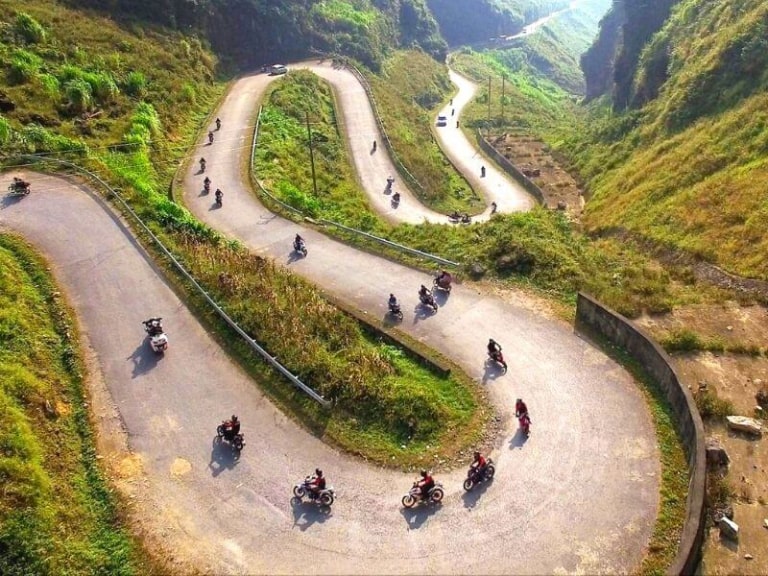
Terraced Rice Fields: In areas like Hoang Su Phi, the mountainsides are transformed into verdant staircases of rice paddies, particularly breathtaking during the planting season (May-June) when they shimmer like mirrors, or the harvest season (September-October) when they glow in hues of gold.
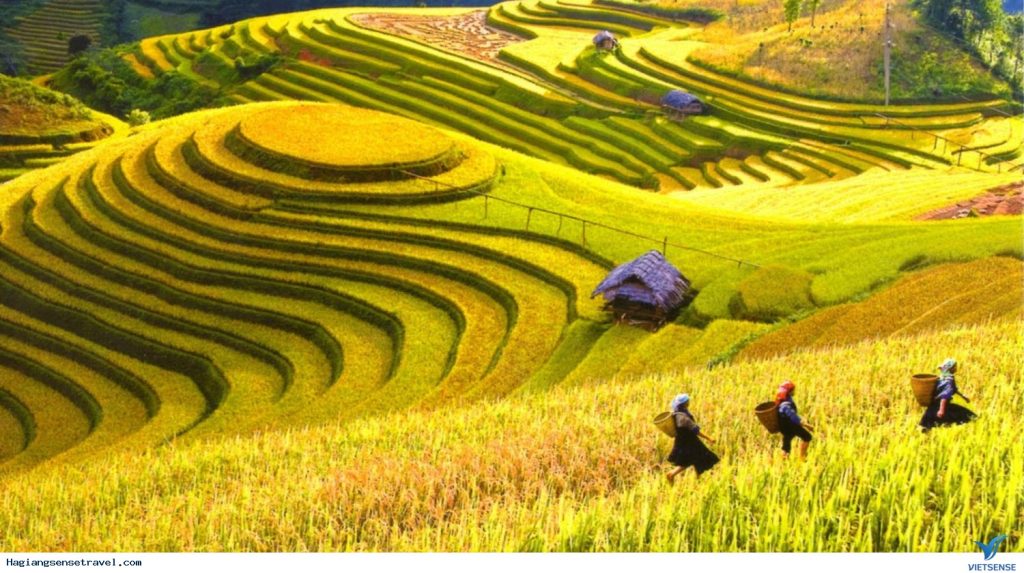
Rich Ethnic Diversity: Ha Giang is home to numerous ethnic minority groups, including the Hmong, Tay, Dao, Nung, and Lo Lo, each with their own distinct languages, customs, traditional clothing, and vibrant markets. Interacting with these communities offers an invaluable cultural immersion.
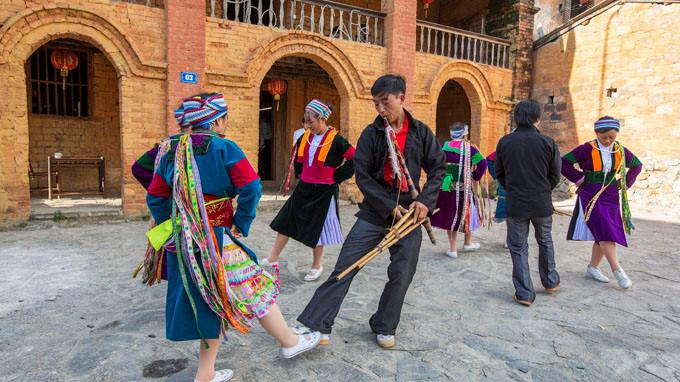
Authentic Experiences: Unlike more heavily trafficked tourist destinations, Ha Giang retains a raw, untouched feel. Opportunities for genuine cultural exchange, serene homestays, and off-the-beaten-path adventures are plentiful.
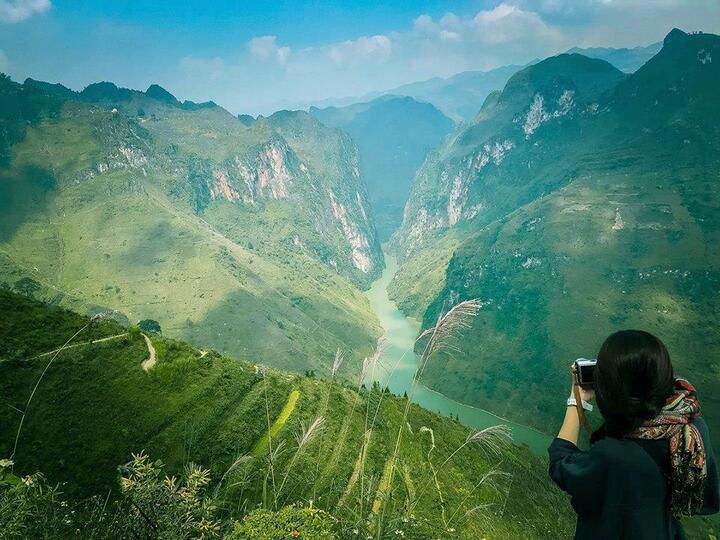
Maybe you are interested: Discover the Enchanting Natural Beauty of Moc Chau, Son La – Ninh Binh Transportation
The Legendary Ha Giang Loop: Your Road to Discovery
The Ha Giang Loop is more than just a route; it’s an experience that has captivated adventurers worldwide. This approximately 350-kilometer circuit (though many variations exist) winds its way through the most breathtaking parts of the Dong Van Karst Plateau Geopark, connecting Ha Giang City with Quan Ba, Yen Minh, Dong Van, and Meo Vac.
How to Conquer the Loop:
- Motorbike (Self-Drive): This is the most popular and exhilarating way to experience the Loop. It offers ultimate freedom and a profound connection to the landscape.
- Requirements: You’ll need a valid international driving permit for motorbikes (a standard car license often isn’t enough for Vietnamese police checks, though enforcement varies). Be an experienced rider; these roads are challenging with steep inclines, sharp turns, and sometimes unpredictable conditions.
- Rental: Motorbike rentals are readily available in Ha Giang City. Expect to pay around 150,000 – 300,000 VND per day ($6-$12 USD) for a semi-automatic or manual bike. Always thoroughly check the bike’s condition (brakes, lights, tires) before setting off.
- Safety Gear: Always wear a helmet (provided by rental shops), and consider bringing your own gloves, elbow/knee pads, and sturdy closed-toe shoes.
- Motorbike with Easy Rider: For those who want the thrill of the motorbike without the stress of driving, hiring an “Easy Rider” (a local guide who drives you on their motorbike) is an excellent option.
- Benefits: Safety is paramount, as local drivers are incredibly skilled and familiar with the terrain. You can relax, enjoy the scenery, and gain insights from a local perspective.
- Cost: Easy Rider tours typically range from $50-$80 USD per person per day, including the driver, motorbike, fuel, and often accommodation. While more expensive than self-driving, it’s a worthwhile investment for a stress-free and enriching experience.
- Car with Driver: For families, groups, or those preferring maximum comfort and safety, hiring a private car with a local driver is ideal.
- Benefits: Air-conditioned comfort, space for luggage, and the ability to stop whenever you wish for photos. Your driver will also serve as a de facto guide, sharing local knowledge.
- Cost: This is the most expensive option, but offers unparalleled comfort. Prices vary depending on the itinerary and duration, but expect to pay $100-$150+ USD per day for a private car and driver.
- Local Bus/Public Transport (Least Recommended for the Loop Itself): While you can take local buses between some towns, this isn’t recommended for truly experiencing the Loop’s beauty. Buses often stick to main roads and won’t stop for scenic viewpoints. It’s better for reaching Ha Giang City from Hanoi.
Typical Ha Giang Loop Itinerary (3-5 Days):
Most travelers opt for a 3-night, 4-day loop, allowing for a good balance of riding and exploration.
Important Notes for the Loop:
- Road Conditions: Roads are generally well-maintained, but prepare for winding, steep, and sometimes narrow stretches. Landslides can occur during the rainy season.
- Permits: A permit is required for foreigners traveling in border areas, including parts of the Dong Van Karst Plateau Geopark. This is usually arranged by your motorbike rental company or Easy Rider, or can be obtained at the Ha Giang Immigration Office.
- Fuel & ATMs: Fuel stations are available in major towns (Quan Ba, Yen Minh, Dong Van, Meo Vac). ATMs are primarily found in Ha Giang City, Dong Van, and Meo Vac. Carry enough cash.
- Connectivity: Mobile signal can be patchy in remote areas. Download offline maps (Google Maps, Maps.me) before you go.
Best Time to Visit Ha Giang: Chasing the Perfect Vistas
Ha Giang’s weather is highly seasonal, and the “best” time to visit often depends on what you want to see.
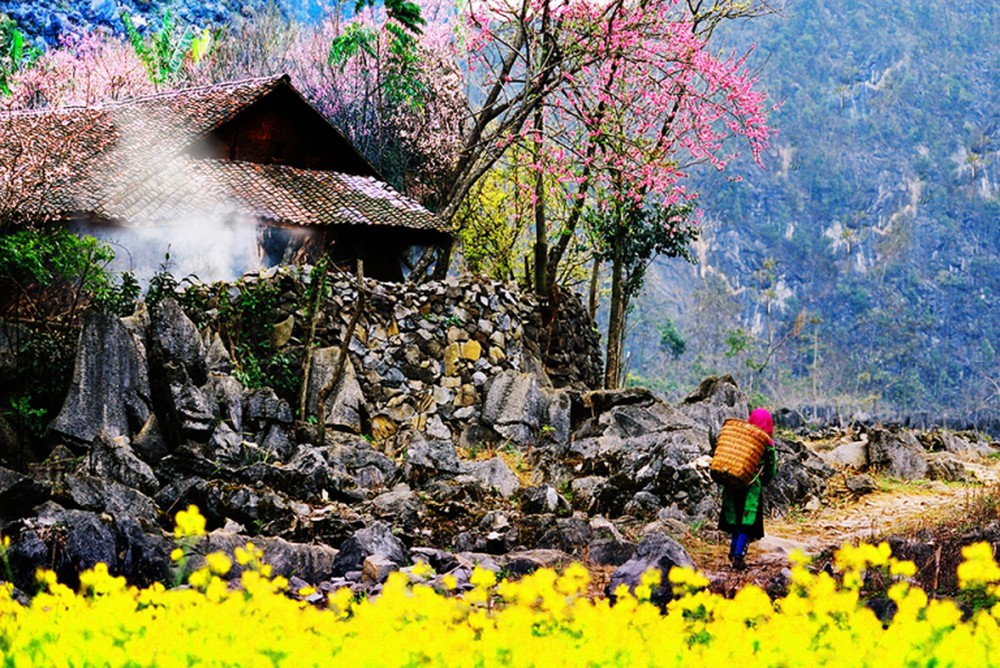
- Spring (March – May):
- Pros: Pleasant temperatures (15-25°C), blooming flowers (peach, plum, mustard fields), clear skies, relatively dry. Ideal for comfortable riding and vibrant photo opportunities.
- Cons: Can still be chilly in the mornings and evenings, especially at higher altitudes.
- Summer (June – August):
- Pros: Lush green landscapes, active rice paddies (especially early in the season), fewer tourists.
- Cons: This is the rainy season. Expect frequent, heavy downpours which can make roads slippery and increase the risk of landslides. High humidity and warmer temperatures (25-35°C). While beautiful, it’s the most challenging time for riding.
- Autumn (September – November):
- Pros: Often considered the absolute best time. Cooler, drier weather (18-28°C), clear skies, and most importantly, the golden rice harvest season (late September-early October) transforms the terraced fields into a breathtaking spectacle. Buckwheat flowers also bloom in late October/November.
- Cons: Can be more crowded, especially during peak harvest season.
- Winter (December – February):
- Pros: Dry weather, stunning fog-laden landscapes, low tourist numbers. Experience local festivals.
- Cons: Cold temperatures (sometimes dropping to near freezing, especially at night and in higher altitudes), often foggy, which can obscure views.
For your 2025 trip, aim for late September to early November for the iconic golden rice fields and pleasant weather, or March to April for blooming flowers and comfortable riding conditions.
Maybe you are interested: Tips for Traveling to Cat Ba Island in 2025 – Halong Transportation
Packing Essentials for Your Ha Giang Adventure
Pack light but smart, keeping the varying weather and active nature of the trip in mind.
- Clothing:
- Layers are key: T-shirts, long-sleeved shirts, a warm fleece or jacket.
- Rain gear: A waterproof jacket and trousers are essential, regardless of the season.
- Sturdy long pants for riding and protection.
- Warm hat and gloves if traveling in cooler months.
- Footwear:
- Comfortable, broken-in hiking boots or sturdy sneakers with good grip.
- Sandals or flip-flops for evenings.
- Safety & Comfort:
- Sunscreen, sunglasses, wide-brimmed hat.
- Insect repellent (essential).
- Basic first-aid kit (band-aids, antiseptic wipes, pain relievers, any personal medications).
- Small backpack for day trips/riding.
- Reusable water bottle (reduce plastic waste!).
- Technology:
- Power bank for charging devices (electricity can be unreliable in remote homestays).
- Camera with extra batteries/memory cards.
- Offline maps downloaded to your phone.
- Documents:
- Passport and visa (if required).
- International Driving Permit (IDP) if self-driving.
- Travel insurance details.
- Copies of all important documents (digital and physical).
Cultural Immersion: Beyond the Scenic Roads
Ha Giang’s true magic lies not just in its landscapes, but in its people. Take every opportunity to engage with the local communities.
- Homestays: Opt for homestays in villages like Du Gia or Lung Cu. This provides an authentic glimpse into local life, allowing you to share meals, observe daily routines, and learn about traditional customs. Many homestays offer delicious home-cooked meals.
- Local Markets: Visit the bustling weekly markets (e.g., Dong Van market, Meo Vac market). These are vibrant cultural melting pots where ethnic minorities from surrounding villages come to trade goods, socialize, and showcase their colorful traditional attire.
- Traditional Crafts: Look out for handmade textiles, intricate embroidery, and traditional musical instruments. Buying directly from local artisans supports their livelihoods.
- Cuisine: Don’t shy away from trying the unique local dishes.
Ha Giang’s Culinary Delights: A Feast for the Adventurous Palate
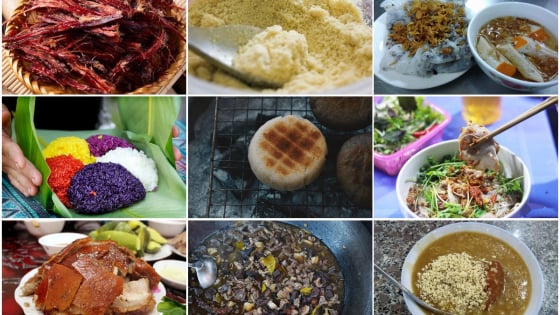
Ha Giang’s cuisine is a hearty reflection of its mountainous terrain and the ingenuity of its ethnic communities. Expect fresh, seasonal ingredients and dishes that are both comforting and flavorful.
Must-Try Dishes:
- Thang Co (Horse Hotpot): A traditional Hmong dish, Thang Co is a rich and savory stew made from horse meat and offal, simmered with various herbs and spices. It’s an acquired taste for some, but a definitive local experience. Often served with corn wine.
- Au Tau Porridge (Chao Au Tau): A unique and medicinal porridge made from the “Au Tau” root (a type of aconite), which is detoxified through a lengthy cooking process. It’s often combined with rice, pork, and herbs, and is believed to be revitalizing, especially after a cold day.
- Five-Colored Sticky Rice (Xoi Ngu Sac): Visually stunning and delicious. Sticky rice is dyed naturally using local plants (red from gấc fruit, yellow from turmeric, green from pandan leaves, purple from magenta leaves, white from plain rice). Each color often represents an element in Vietnamese philosophy.
- Men Men (Steamed Corn Flour): A staple food, especially among the Hmong, made from ground corn. It’s steamed until fluffy and often served with local stews or vegetables. A simple yet filling dish reflecting the region’s agricultural heritage.
- Buckwheat Cake (Banh Tam Giac Mach): Made from buckwheat flour, this cake is a popular snack, especially during the buckwheat flower season (late October/November). It has a slightly earthy, sweet flavor.
- Dong Van Rolled Rice Cakes (Banh Cuon Dong Van): Unlike Banh Cuon elsewhere, Ha Giang’s version is typically served with a clear, hot pork bone broth instead of fish sauce, and often contains egg or minced pork. It’s a comforting breakfast staple.
- Smoked Buffalo/Pork (Thit Trau Gac Bep/Thit Lon Gac Bep): Meat smoked over a wood fire, giving it a distinctive flavor and texture. Perfect for snacking or as part of a meal.
Where to Eat:
- Homestays: Many homestays offer communal dinners, which are an excellent way to experience authentic home-cooked meals and interact with your hosts and fellow travelers. These are usually set menus at a fixed price.
- Local Eateries (Quán Ăn): Scattered throughout towns like Dong Van, Meo Vac, and Ha Giang City, these small, often family-run establishments serve up fresh, local fare. Look for places bustling with locals – a sure sign of good food. Prices are very affordable, typically 50,000 – 150,000 VND ($2-$6 USD) per dish.
- Market Stalls: The vibrant markets are fantastic places to sample street food, snacks, and local drinks.
- More Tourist-Oriented Restaurants: In larger towns, you’ll find some restaurants that cater more to tourists, offering wider menus and English-speaking staff. Prices here will be slightly higher but still very reasonable, perhaps 100,000 – 300,000 VND ($4-$12 USD) for a main course.
Comparison of Dining Experiences:
- Local Eateries vs. Homestays: Local eateries offer variety and flexibility, while homestays provide a more intimate and authentic cultural experience with often pre-set, delicious meals. If you want to explore different dishes daily, eateries are great. If you prefer a curated local meal and cultural interaction, homestays are superior.
- Budget: Local eateries and market stalls are the most budget-friendly. Homestay meals are typically a good value for the quality and experience. Tourist-oriented restaurants will be slightly pricier but still far more affordable than Western dining.
- Atmosphere: Local eateries are bustling and authentic. Homestays offer a cozy, family-like atmosphere. Tourist restaurants are more relaxed and often have modern amenities.
Embrace the culinary adventure in Ha Giang. Don’t be afraid to point at dishes or use translation apps; the rewards are truly delicious!
Essential Logistics: Getting to and Around Ha Giang
Reaching Ha Giang requires a journey, but the spectacular rewards make every mile worth it.
- From Hanoi to Ha Giang City:
- Overnight Sleeper Bus: The most popular option. Buses depart from various Hanoi bus stations (My Dinh, Giap Bat) in the evening and arrive in Ha Giang City early the next morning (6-8 hours).
- Limousine Van: A more comfortable and slightly faster option, these vans seat around 9-16 passengers and offer more legroom. They operate both day and night.
- Private Car: The most comfortable and flexible option, though also the most expensive. Ideal for groups or those prioritizing convenience. A private car from Hanoi to Ha Giang City can cost $200 USD.
- Getting Around Ha Giang: Once in Ha Giang City, you’ll arrange your motorbike rental, Easy Rider, or private car for the Loop.
For a seamless and comfortable journey to and from Ha Giang, especially for your crucial connections, consider booking your transportation with a reliable service like Halongtransportation.com.
Maybe you are interested: Halong Bay Transfer Service & Cruises – Halong Transportation
Why choose Halongtransportation.com for your Ha Giang travel needs?
- Beyond Ha Long Bay: While their name suggests a focus on the stunning Halong Bay, Halongtransportation.com offers extensive services across Northern Vietnam, connecting key tourist hubs and ensuring you reach your adventure destination smoothly.
- Reliability & Punctuality: Crucial for catching buses or starting your Loop early. Their professional drivers are known for their punctuality and knowledge of the routes.
- Comfort & Safety: Travel in modern, well-maintained vehicles, whether you choose a spacious limousine van for a comfortable journey from Hanoi to Ha Giang City, or a private car for tailored convenience. Prioritize your safety on the winding roads by choosing experienced transport.
- Tailored Solutions: Need a direct transfer from Hanoi’s airport to Ha Giang City? Or perhaps a private car to take you from a remote part of the loop back to a major city? Halongtransportation.com can arrange customized itineraries to fit your travel plans before and after your Ha Giang adventure.
- Peace of Mind: After navigating the challenging but exhilarating roads of the Ha Giang Loop, you’ll appreciate a comfortable and stress-free transfer back to your next destination. Let Halongtransportation.com handle the logistics, so you can simply relax and reminisce about your incredible journey.
- Competitive Pricing: They offer transparent pricing and excellent value for money, especially when considering the comfort and reliability they provide.
Don’t let travel logistics add stress to your epic adventure. Secure your comfortable and reliable transfers to and from Ha Giang with Halongtransportation.com. Focus on the breathtaking views, the rich culture, and the thrill of the open road, knowing your journey is in expert hands.
Responsible Tourism: Preserving Ha Giang’s Magic
As Ha Giang’s popularity grows, responsible tourism becomes ever more vital.
- Support Local: Choose locally-owned homestays, eat at local restaurants, and buy crafts directly from artisans. Your tourism dollars have a direct and positive impact on the communities.
- Respect Culture: Dress modestly when visiting villages and temples. Ask permission before taking photos of people. Learn a few basic Vietnamese phrases – a simple “Xin chào” (hello) or “Cảm ơn” (thank you) goes a long way.
- Minimize Environmental Impact: Stick to marked trails, don’t litter, and reduce plastic consumption.
- Drive Safely: If self-driving, prioritize safety. Don’t speed, be aware of livestock and other vehicles, and never drive under the influence.
The Unforgettable Call of the Northern Highlands
Ha Giang is more than just a place you visit; it’s a place that stays with you. The vastness of the landscapes, the warmth of its people, and the sheer exhilaration of the journey will leave an indelible mark on your memory. It’s a destination that challenges you, inspires you, and ultimately, rewards you with an experience unlike any other.
So, pack your bags, prepare your spirit of adventure, and get ready to answer the call of Vietnam’s untamed north. Your unforgettable Ha Giang journey awaits. And remember, for every mile of your epic adventure, from Hanoi’s bustling streets to the majestic peaks of Ha Giang, Halong Transportation is ready to ensure your travel is as smooth and comfortable as the views are breathtaking.
